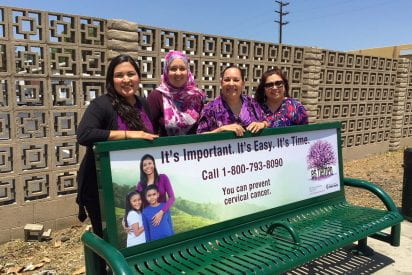BY Paul Boutin
USC’s local campaign to encourage Hispanic women to get tested for cervical cancer extends further into the community this year, with the hiring of local health care professionals who already work with residents.
Es Tiempo is an annual public awareness campaign that was conceived a few years ago when Laila Muderspach, chair of the Los Angeles County+USC Medical Center’s Department of Obstetrics and Gynecology, observed that women in the Hispanic communities around L.A. County had unusually high rates of cervical cancer, which can be fatal if not diagnosed early. Pap smear tests every few years and a vaccination at a young age against the human papillomavirus (HPV) that can cause cervical cancer have proven effective in reducing the number of late-stage diagnoses.
“Dr. Muderspach believed it was not only access, but lack of information,” said Lourdes Baezconde-Garbanati, one of the program’s principal investigators in the Department of Preventive Medicine at the Keck School of Medicine of USC. “Women didn’t know about coming in for screening or that they have to do that regularly.”
But communicating that information to the community required a broad field of talent and expertise. The result was a multidisciplinary effort that included the USC Annenberg School for Communication and Journalism Professor Sheila Murphy and the Designmatters program at the Art Center College of Design, Baezconde said.
Baezconde-Garbanati noted that the interdisciplinary team conducted a dozen focus groups.
“We took students and faculty from the Designmatters program to local clinics to observe what was going on, what the clinics were like, and to see how a Pap smear was done on a dummy. It was quite eye-opening for students coming from the world of design.”
Cervical cancer prevention and Pap smears
Working with local residents as well, the team developed a campaign that associates regular Pap smears with the yearly springtime purple bloom of the Jacaranda Trees in local neighborhoods — Boyle Heights and other areas of East Los Angeles. When the trees are in bloom, signs on billboards, bus benches and lamp posts announce that es tiempo — literally “it’s time” to get tested or have one’s sons and daughters vaccinated against HPV.
The signs tout in both Spanish and English that testing is safe, important and easy. They display a toll-free phone number that women can call at the Office of Women’s Health to get more information on where to get tested, possibly at reduced or no cost.
The team also produced The Tamale Lesson, a 12-minute video available in Spanish and English in which a young woman explains to others gathered in a Hispanic family kitchen getting ready for a quinceañera how a Pap test works, using a chicken to demonstrate. She dismisses several common myths about testing and cancer, and the film takes a sad turn as it reveals that undetected cancer has already taken its toll in the family. This prompts the women in the family to go in for a screening, even those who did not think they were at risk.
Health care professionals step in to help

Now in its fourth year, the Es Tiempo program is extending its roots from USC staff into the local health care network.
“We have data that show changes in knowledge, attitudes and beliefs in the community as a whole regarding cervical cancer and have been working with our clinic partner, Clinicas Moñsenor Oscar Romero,” Baezconde said. “We no longer need to test the campaign. We just need to put it out there in the community.”
To that end, USC has hired and trained women who work locally as promotoras de salud (community health care professionals) and others who have an established relationship with local residents through clinics, churches and community agencies.
“Promotoras de salud are trained, they are from the community and have won the trust of the community. These women are very well known in the communities where they work,” Baezconde-Garbanati said.
What began as a physician’s urgent concern is becoming a regular part of community-run health care.
“Ideally, there will be a point where we no longer put out the campaign,” Baezconde-Garbanati said. “Women will just see the trees blooming and say, ‘It’s time.’”
